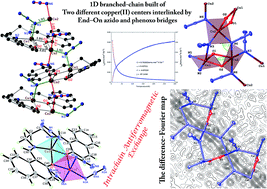Intrachain antiferromagnetic exchange in a 1D branched-chain built of two different copper(ii) centres interlinked by end-on azido and phenoxo bridges: electron density map, electrochemical and magnetic properties†
Abstract
A 1D, end-on azido- and phenoxo-bridged, coordination polymer, [Cu2(μ-NAPPR)(μ1,1-N3)2]n (1), (NAPPR2− = 1,3-bis(naphthylideneimino)propane dianion), was synthesized and characterized. The 1D branched-chain is built of two types of slightly different, square-pyramidal, Cu(II) ions with different sets of donor atoms. Temperature- and field-dependent magnetic analyses reveal an antiferromagnetic interaction between copper centres in the main chain (Cu2) mediated by EO-azide bridges along the chain. The interaction between the copper centres Cu1 (in the branches of the main chain) and Cu2 is very weak and is included by means of an own Weiss constant θ′. The electron density map of 1 from synchrotron data shows that the dx2−y2 orbitals of Cu2 are not well described by the procrystal model, a difference which might be meaningful for the magnetic properties. Cyclic voltammetry studies show two different redox waves with a large difference between the redox potentials of the two types of copper centres (1.21 V). The resulting data are consistent with the crystal structure of this complex determined by single crystal X-ray diffraction.


 Please wait while we load your content...
Please wait while we load your content...